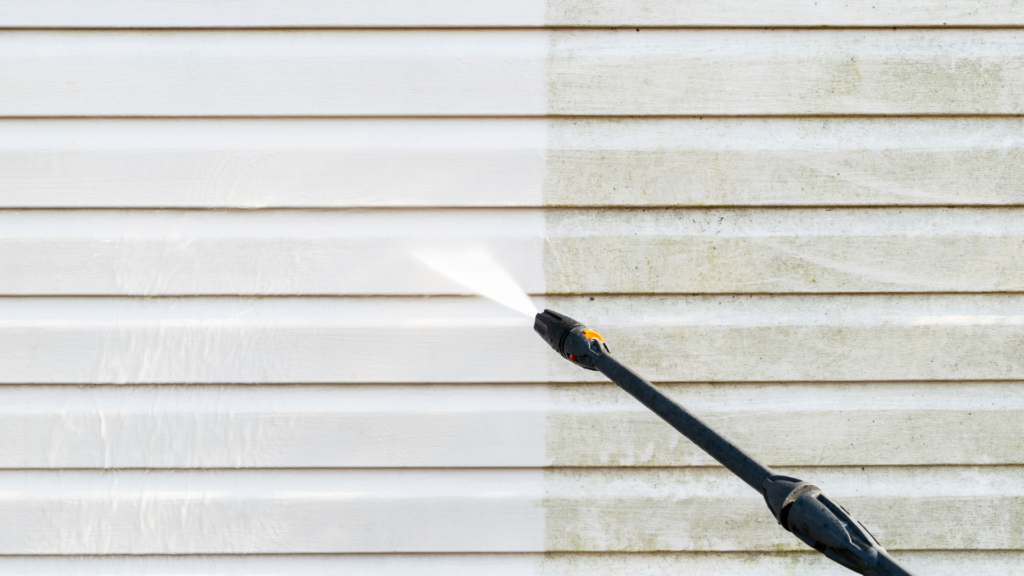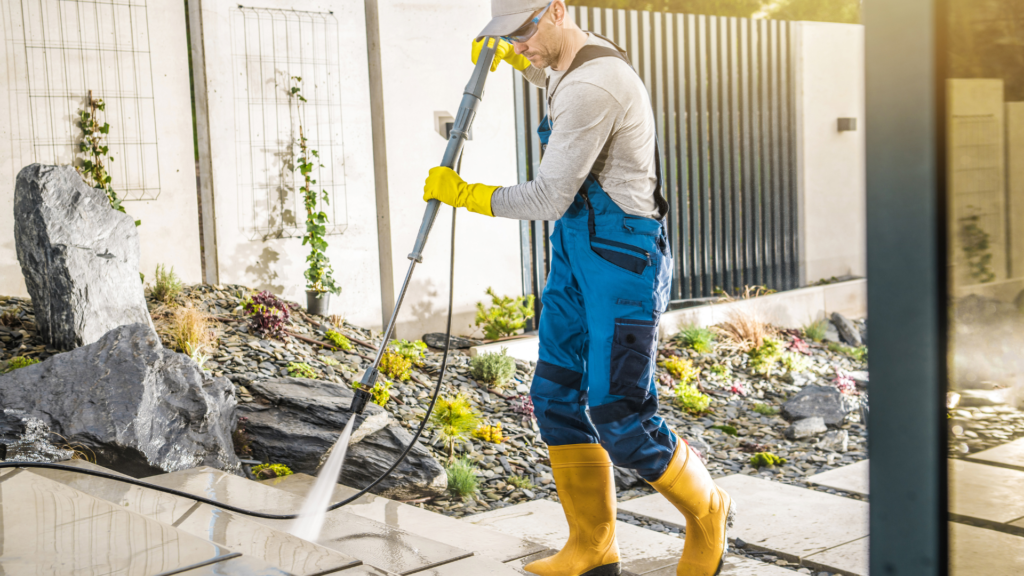A clean and fresh exterior not only looks great but also protects your property from damage. One of the most effective ways to achieve this is through power washing. Power washing is a cleaning technique that uses high-pressure water spray to remove dirt, grime, and other unwanted substances from various surfaces. It saves time and ensures a deeper clean than traditional cleaning methods. But do you know which surfaces can be safely power washed? Or how to avoid damaging them while doing so? In this blog post, we will cover everything you need to know about power washing – from understanding the technique to exploring different surfaces that can be power washed without causing any harm. We will also talk about essential equipment needed for power washing and whether it’s better as a DIY task or if you should hire a professional. Get ready to unlock the magic of power washing!

Understanding Power Washing
Power washing, also known as pressure washing, is a cleaning technique that involves using high-pressure water to remove grime and stains from various surfaces. It is an effective method for giving your home’s exterior a fresh and clean look. Whether it’s siding, driveways, or other outdoor areas, power washing can make a big difference in the appearance of your property.
To enhance the results of power washing, you can use hot water and cleaning products specifically designed for this purpose. This combination helps to break down tough dirt and stains, leaving the surfaces looking their best. Power washing can be done using different equipment, such as a pressure washer, garden hose, or even a spray bottle, depending on the size and complexity of the affected area.
By utilizing the power of high-pressure water and appropriate cleaning solutions, power washing can effectively remove contaminants like dirt, mold, mildew, grease, and even rust stains. It is a great idea to consider power washing as a low-maintenance and eco-friendly alternative to harsh chemicals and excessive scrubbing.
Different Surfaces You Can Power Wash
Power washing is a versatile cleaning method that can be used on various surfaces. It is suitable for wooden, concrete, brick, and metal surfaces, making it a great idea for maintaining the cleanliness and appearance of your home’s exterior. You can power wash siding, decks, patios, driveways, and fences to remove stains, grime, mold, and mildew effectively. However, it is important to note that different surfaces may require different pressure washing techniques and cleaning solutions. For instance, using a high pressure on delicate wooden surfaces may cause damage. To ensure each surface is treated correctly, hiring a professional power washing service is recommended. They have the expertise to determine the appropriate pressure and cleaning solution for each affected area. By power washing your home’s exterior regularly, you can keep it looking clean and fresh with minimal effort and low maintenance.
Power Washing Wooden Surfaces
Power washing wooden surfaces requires gentle pressure to avoid any potential damage. This method effectively eliminates stains, mold, mildew, and built-up grime from wood. To power wash wood, it is recommended to use a combination of warm water, detergent, and a soft brush or car wash mitt. By using these tools, the natural beauty of wooden decks, fences, and siding can be fully restored. Moreover, regular power washing helps maintain wooden surfaces, extending their lifespan. Remember, power washing wooden surfaces should be done carefully to prevent any harm to the wood. With the right techniques and equipment, power washing wood can be a great way to keep your exterior looking clean and fresh.
Power Washing Concrete and Brick Surfaces
Power washing concrete and brick surfaces is an effective way to remove stains, dirt, and algae buildup. With high pressure power washing, you can achieve great results in cleaning these surfaces. Using hot water, high pressure, and a suitable cleaning solution can help get rid of rust stains, red clay stains, and other stubborn marks from concrete and brick. However, it is important to use the appropriate nozzle, spray pattern, and distance when power washing these surfaces to avoid causing damage or pitting. By following these guidelines, you can ensure that your power washing efforts on concrete and brick surfaces are successful in restoring their clean and fresh appearance. Remember, power washing can be a great idea for maintaining the exterior of your home or property, but it’s always best to consult a professional if you’re unsure about the process.
Power Washing Metal Surfaces
Power washing metal surfaces, like stainless steel, can effectively eliminate grime, grease, and residue. For the best results, it is recommended to use low pressure and warm water with detergent when power washing metal. This method not only restores the shine and cleanliness of metal surfaces but also helps remove corrosion and rust stains, enhancing both appearance and longevity. Metal gutters, siding, and outdoor furniture can greatly benefit from power washing, as it ensures a thorough cleaning. By utilizing the right techniques and equipment, you can effortlessly maintain these metal surfaces, which require little maintenance in everyday use. Unlike using harsh chemicals and excessive water, power washing with low pressure and warm water remains a great idea for preserving the beauty and durability of metal.

Essential Power Washing Equipment
When it comes to power washing, having the right equipment is crucial for achieving the best results. The primary tool you’ll need is a pressure washer, which is available in various sizes and strengths. Different types of nozzles, such as surface cleaners, turbo nozzles, and adjustable nozzles, are used for different cleaning applications. It’s important to choose a high-quality hose that can withstand high water pressure and is long enough to reach all areas. Specialized detergents can be used to effectively remove stubborn stains and grime. Lastly, don’t forget about safety gear. Wearing protective gear like goggles, gloves, and shoes is essential to avoid any potential injuries. By having the essential power washing equipment, you’ll be equipped to tackle any cleaning task with ease.
Choosing the Right Power Washer
When choosing a power washer, consider the power source (gas or electric), PSI, GPM, nozzles, and portability/storage. Gas washers offer more power but require maintenance, while electric washers are convenient and easier to use. The PSI determines water force, and a lower PSI is sufficient for general cleaning tasks. Higher GPM cleans larger surfaces efficiently, while lower GPM is ideal for delicate surfaces. Different nozzles provide versatility. Consider your needs and budget to make the right choice.
Safety Gear for Power Washing
When power washing, it’s crucial to prioritize your safety by wearing appropriate gear. One essential item is protective eyewear; goggles shield your eyes from water and debris. Additionally, non-slip shoes with good traction are essential to prevent accidents on wet surfaces. Gloves protect your hands from chemicals and hot water, while a respirator mask safeguards your lungs from harmful substances and debris. Lastly, use earplugs or earmuffs to protect your hearing from the loud noise of the power washer. By wearing these safety gear items, you can ensure a safe and enjoyable power washing experience. Remember to prioritize your well-being as you tackle your cleaning tasks!
Is Power Washing a DIY task or should you hire a professional?
Considering your budget, time constraints, and comfort level with DIY tasks, it’s important to decide whether to power wash on your own or hire a professional. While it can be a DIY task, it requires knowledge and experience to avoid damage or injuries. Hiring a professional ensures the job is done correctly and they have access to commercial-grade equipment and cleaning solutions.
Conclusion
In conclusion, power washing is a highly effective method for cleaning and refreshing various exterior surfaces. Whether you have wooden decks, concrete driveways, or metal fences, power washing can remove dirt, grime, mold, and stains, restoring the appearance of your property. However, when working with delicate surfaces like wood, it’s important to follow proper techniques to avoid damage. It’s also crucial to use the right power washer and wear appropriate safety gear to ensure a successful and safe cleaning process. While power washing can be a DIY task, hiring a professional can save you time and ensure optimal results. So, whether you choose to tackle it yourself or hire a professional, power washing can work its magic and leave your exterior looking clean and fresh. Contact us today or visit our website to learn more about our power washing services and how we can help you achieve a spotless exterior.


